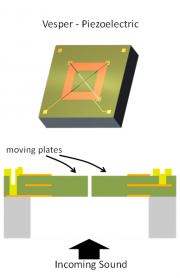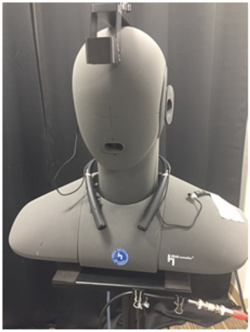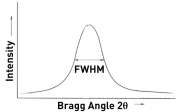MEMS Microphones
MEMS microphones have been growing rapidly in recent years for a variety of applications, primarily mobile devices, but also other products such as hearing aids, Bluetooth headsets, and “digital assistants”.
下載The market for MEMS microphones has been growing rapidly in recent years for a variety of applications, primarily mobile devices, but also other products such as hearing aids, Bluetooth headsets, “digital assistants” (like Amazon Echo / Google Home) and increasingly in cars. According to Yole Développement[1], the consumer MEMS microphone market is expected to be worth $1.5B in 2024, up from $1.1B in 2019, with the largest growth forecast to be in smart speakers (13% CAGR) and wireless earbuds (29% CAGR). Microphones in smartphones today do more than simply capture voice for transmission. They also serve as audio sensors in a very low power mode to support voice activation, and they provide high quality audio when the phone is used for video recording. Beyond smartphones and digital assistants, applications in automotive may include infotainment and communication systems, voice commands, noise cancellation and safety features[2].
Compared to traditional Electret Condenser Microphones (ECM), MEMS microphones offer a smaller footprint/thickness, a higher signal to noise ratio (SNR) than an ECM of an equivalent size, lower power consumption and are easier to package in an automated PCB assembly, unlike ECM. Their reduced size allows arrays of multiple MEMS microphones to be used in small products like mobile phones or Bluetooth headsets to recognize sound directionality and most importantly to provide noise cancellation capability. Silicon MEMS microphones also offer greater immunity to radio-frequency interference (RFI) and electromagnetic interference (EMI), and they can withstand the high temperatures of a surface-mount technology (SMT) process. With a low mass of the diaphragm a MEMS microphone is far less sensitive to vibrations/mechanical shock than an ECM[2].
The first capacitive, or condenser, microphones were developed at Bell Labs in 1916. Traditional condenser microphones are air gap capacitors with a back-plate and a flexible diaphragm. Modern capacitive MEMS microphones operate on the same principle and are basically miniaturized condenser microphones manufactured in a silicon wafer process. Capacitive microphones use a diaphragm and a back-plate to form an air gap capacitor with a high bias charge. When the diaphragm moves in response to sound, the capacitance changes and the resulting voltage is amplified.

Fig 1 Capacitive MEMS microphone principles: 1) Single back-plate, 2) Dual back-plate, and 3) Sealed dual-membrane
[Source: Infineon]
The dual back-plate design[3] produces a differential (compared to single-ended) output, which minimizes distortion due to its symmetrical construction. A differential element is also more readily managed through the audio processing chain, which potentially reduces power requirements for the accompanying ASIC. It also reduces RF interference, resulting in fewer signal processing steps.
At ECTC2019, Infineon presented a fully functioning single membrane MEMS microphone within a fan-out e-WLB (embedded Wafer Level Ball Grid Array) package - an important step in miniaturization and cost-effective integration with other chips in a single package[4]. In the same year they also released a new microphone design which consisted of one plate between two membranes which improves the Signal-to-Noise Ratio (SNR) even further and provides better protection against water ingress or particles.

Fig 2 400µm deep cavity etch. Silicon etch rate of 12µm/min (26% open area)
A piezoMEMS microphone uses the piezoelectric effect of specific materials, such as aluminium nitride (AlN), which generates an electrical signal when the diaphragm made of such material is deformed by a sound wave.

Fig 3 PiezoMEMS microphone [Source: Vesper Technologies, Inc]
Without an enclosed air gap, acoustic damping (a major source of noise in capacitive microphones) is eliminated, and recent developments using scandium-doped AlN have shown continued improvements in sensitivity and SNR in line with capacitive MEMS microphones. At the same time, they are more robust and less susceptible to degradation over time because piezoMEMS microphones lack the small capacitive gap that is sensitive to dust or moisture. Without the need for a charge pump they also have a faster start-up time than capacitive MEMS microphones.
Finally, the leading piezoMEMS microphone manufacturer, Vesper, explains[5] that to achieve accurate wake word recognition, capacitive microphones are continuously running Voice Activity Detect (VAD) algorithms to listen for the wake word (e.g. “Alexa” or “Siri”). As an alternative, a single piezoMEMS microphone, using a tiny fraction of the power, can be used to trigger the voice system-on-a-chip (SoC) or microcontroller (MCU) which then wakes up the other digital microphones in the array to capture the wake word. This solution can save significant battery power, although all the other microphones also need to be fast-acting so they don’t miss the first part of the wake word and cause recognition errors. This opens up a lot of new applications where a constant power drain makes voice-control impractical in battery powered devices, particularly in applications such as wearable devices, where space for a large battery is not available.
In Dec 2019 Vesper’s technology received Amazon certification for extended battery and far-field voice interactions, and it has been employed within Shenzhen Horn’s LuduanV4 headset - the first hand-free, extended battery life Alexa-enabled headset with Vesper’s ZeroPower Listening™ (ZPL)[6] solution.

Fig 4 Shenzhen Horn LuduanV4 test setup on “Hand and Torso Simulator” [Source: Vesper Technologies, Inc]
|
|
Capacitive MEMS Microphones |
PiezoMEMS Microphones |
|---|---|---|
|
Omega® Si DRIE |
Cavity etch with high silicon etch rate (10-25µm/min) |
Through Si vias for small format packaging |
|
Omega® ICP/Synapse Etch |
Dielectric and metal etching |
Dielectric, metal and high rate AlN/AlScN etching |
|
Primaxx® VHF Etch |
High throughput, stiction-free removal of sacrificial oxide between membrane and back-plate. High selectivity to SiN and Al. |
Removal of sacrificial oxide if used to support piezoelectric film during deposition. Compatible with AlN and AlScN films |
|
XACTIX® XeF2 Etch |
Release Etch - stiction-free removal of sacrificial silicon, with long undercuts through small openings |
Removal of sacrificial silicon if used to support piezoelectric film during deposition |
|
Sigma® PVD |
- |
Deposition if Al/AlScN with superior texture (FWHM<1.5°), stress control and film thickness uniformity |
|
Delta® PECVD |
Deposition of sacrificial oxide layers. Deposition of SiOx and SiN diaphragm films with excellent stress control |
- |
|
MVD® |
Deposition of anti-stiction, hydrophobic and charge control coatings |
Deposition of anti-stiction, hydrophobic and charge control coatings |
Summary
With the evolution of smartphones and many new voice-activated products, the demand for smaller, energy-efficient microphones is expected to continue to grow rapidly over the next few years. SPTS’s etch and deposition technologies offer makers of both capacitive and piezo-based MEMS microphones the process capabilities they require throughout the production process.

*FWHM = Full Width Half Maximum – This is a measure of the spread of x-ray diffraction (XRD) from a sample. A perfect crystal will produce a very sharp peak (i.e a very low FWHM), while defects like dislocations, mis-aligned grains and curvature due to non-uniform deposition, will result in a broader XRD curve and a higher FWHM
References
[1] Microphones, Microspeakers and Audio Solutions – Market and Technology Trends”, Yole Développement (Dec 2019)
[2] http://www.aecouncil.com/W.4a_Microphone_MEMs_Qualification_Update.pdf
[3] http://www.analog-eetimes.com/news/mems-microphone-design-better-audio
[4] A MEMS Microphone in a FOWLP” H. Theuss et al, Proc of 2019 IEEE 69th Electronic Components and Technology Conference (ECTC), pp855-860
[6] https://evertiq.com/design/47359
Information on this page contains forward looking information. For more information, click here.
MEMS microphones have been growing rapidly in recent years for a variety of applications, primarily mobile devices, but also other products such as hearing aids, Bluetooth headsets, and “digital assistants”.
下載Piezoelectric properties of AlN to convert mechanical strain into an electric signal, or vice versa is being exploited in devices such as RF filters and a growing number of MEMS.
下載The link you have selected is located on another server. Neither SPTS Ltd. nor any of its subsidiaries endorses this web site, its sponsor, or any of the information, policies, activities, products, or services offered on the site or by any advertiser on the site. By clicking on the OK button below, you agree and acknowledge the foregoing and will be directed to the selected site.
